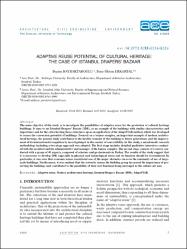Adaptive Reuse Potential of Cultural Heritage: The Case of Istanbul Drapers' Bazaar
Künye
Bayraktaroğlu, Begüm & Erkartal, Pınar. (2023). Adaptive Reuse Potential of Cultural Heritage: The Case of Istanbul Drapers’ Bazaar. Architecture, Civil Engineering, Environment. 16. 1-20. 10.2478/acee-2023-0029.Özet
The main objective of the study is to investigate the possibilities of adaptive reuse for the protection of cultural heritage buildings. It aims to set Istanbul Drapers' Bazaar (IDB), as an example of the buildings with similar characteristics and importance and for the cities hosting those structures upon an application of the AdaptSTAR method, which was developed to assess the conversion potential of buildings. Focused on a bazaar complex, an important example of modern architectural heritage, the present study contributes to the healthy transfer of the building to future generations and the improvement of its international recognition by investigating it in the context of convertibility. In this study, a mixed-mode research methodology including a two-stage approach was adopted. The first stage includes detailed qualitative interviews conducted with the architect and the administrative unit manager of the bazaar complex. The second stage consists of a survey conducted with a group of 45 experts, composed of scholars and professionals in Turkey. The results of the study suggest that it is necessary to develop IDB, especially in physical and technological terms and its function should be reconsidered. In particular, it was seen that economic issues constituted one of the major obstacles via-a-vis the continuity of use of large-scale buildings. Furthermore, it was realized that the artworks across the building group increased the importance of preserving the buildings and contributed to the possibility of their new functions being envisaged in the culture-art axis.

















